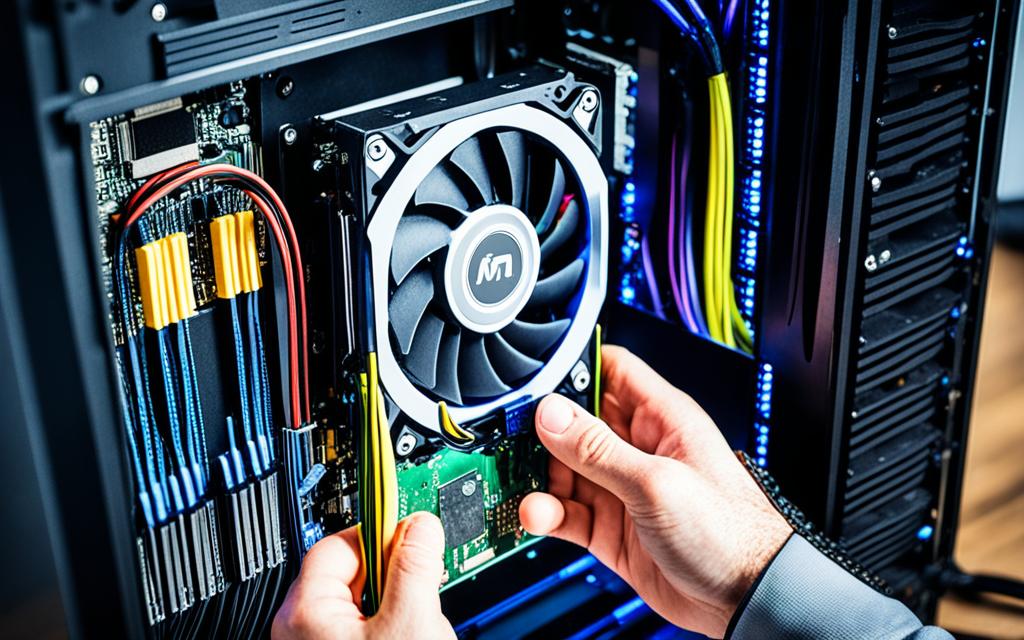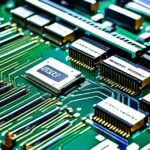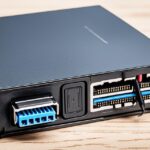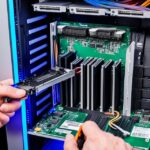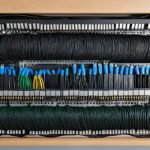Table of Contents
Many people wonder if you need a SATA cable for an M.2 SSD during setup. M.2 SSDs differ from regular hard drives as they don’t need SATA cables. They plug directly into M.2 slots on the motherboard.
This change makes setting up easier and boosts data transfer speed. M.2 drives offer quicker speeds than traditional SATA connections. This makes them great for tasks needing fast data access.
When adding to or building a computer, knowing if you need a SATA cable for an M.2 SSD is key. Read more about SSDs and their benefits for your computer at this informative resource.
Key Takeaways
- M.2 SSDs connect directly to the motherboard, eliminating the need for SATA cables.
- Compared to HDDs, M.2 SSDs offer significantly improved speed and performance.
- Installing M.2 SSDs is straightforward, requiring just a compatible slot.
- M.2 technology supports high-speed data transfer, ideal for modern applications.
- It’s crucial to ensure compatibility with your motherboard when considering M.2 SSD installation.
Understanding M.2 SSDs and Their Advantages
M.2 SSDs have changed how we store data greatly. They offer key M.2 SSD advantages that beat old storage ways. Their shape lets them connect straight to the motherboard. This enables fast data transfer rates and improves system speed.
Speed and Performance Benefits
M.2 SSDs stand out for their amazing speed. NVMe M.2 SSDs can hit speeds up to 20Gbps, way more than the 6Gbps of SATA M.2 SSDs1. This means data can move up to 3,500 MB/s for reading and 3,000 MB/s for writing. It allows quick file moves and better gaming2. These features make programs load faster and the system to start up quicker.
Enhanced Reliability Compared to HDDs
M.2 SSDs are more reliable than old HDDs. HDDs have parts that move and can break, but M.2 SSDs don’t. So, there’s less chance of failure. This means you can trust them with your important files. They are more stable and last longer.
Energy Efficiency and Silent Operation
M.2 SSDs also lead in energy efficiency. They use less power, making them perfect for laptops and small devices. They also run quietly since they have no spinning disks. This means a quieter place to work or relax.
Understanding these benefits is key if you’re thinking about upgrading. Adding M.2 technology to your setup opens up new ways to improve power use and computing speed.
Start your journey towards enhanced performance by learning how to install an SSD in your PC1
What Types of M.2 SSD Connections Exist?
When you’re picking an SSD for your computer, it’s key to know about M.2 connections. These connections differ, mainly in how they link with your computer. There are two main types: NVMe and SATA, each fitting different needs.
NVMe and Its High-Speed Benefits
NVMe has changed the game for solid-state drives with its fast speed. These drives can hit speeds up to 20Gbps, far beyond the 6Gbps peak of SATA SSDs. This means your computer starts faster, files transfer quickly, and you work smoother on big tasks like 4K video editing.
NVMe drives use the PCIe interface, letting data travel on multiple lanes. This design can push read speeds up to 7,000MB/s in some top models3.
Differences Between SATA and NVMe M.2 SSDs
SATA and NVMe M.2 SSDs vary mostly in speed and the way they send data. Although SATA SSDs are quicker than old hard drives, NVMe models are faster still. NVMe drives can reach read speeds of over 3,500MB/s, showing their edge in processing lots of data3.
Also, M.2 connections let SSDs be single or double-sided. This flexibility meets different storage requirements and device designs2.
Do You Need a SATA Cable for M.2 SSD?
It’s key to grasp how SSDs connect to understand if you need a SATA cable for M.2 SSDs. M.2 SSDs link directly with the motherboard, changing how we think about cables. This is unlike traditional SATA SSDs that need cables.
Understanding Interface Connections
M.2 SSDs may follow the SATA or NVMe protocols, plugging into the motherboard’s M.2 slot. In contrast, SATA SSDs need a cable for data. This shows how M.2 tech simplifies connections, removing the need for extra wires. Using M.2 protocols, speeds can soar, with NVMe M.2 SSDs reaching up to 20Gbps1.
SATA vs. M.2: A Comparison of Connection Methods
The gap between SATA and M.2 shows how storage tech has evolved. SATA M.2 SSDs run at 6Gbps, leading to slower load times. NVMe versions, however, can hit 3,500MB/s1. Unlike standard SSDs, M.2 SSDs don’t need a SATA cable. This makes fitting them easier and tidier. NVMe uses PCIe tech to cut boot times, a major upgrade over HDDs4. For those chasing quick and smooth performance, this is a notable improvement.
Required Cables for Different SSD Types
When you add SSDs to your system, knowing the right cables is key for top performance. You’ll need different cables for SATA SSDs and NVMe M.2 SSDs. Here we’ll explain what each type needs for trouble-free setup.
Cables for SATA SSDs
SATA SSDs require two main cables to work well. The SATA data cable links the SSD to the motherboard for transferring data. The SATA power cable supplies power from the power unit to the SSD. Following these steps for SATA SSD requirements ensures good operation and data management4.
Cables for NVMe M.2 SSDs
Unlike SATA SSDs, NVMe M.2 SSDs are easier to install because they need no extra cables. They plug right into the motherboard’s M.2 slot. This makes setup simpler and boosts performance by lowering delay. It also cuts down on the cable clutter that often comes with traditional SSDs5.
General Recommendations for Installation
For smooth installation, here are some tips about SSD cables:
- Make sure all cables are firmly attached to prevent power or data issues.
- Choose high-quality power cables to avoid electrical problems that could harm the SSD.
- Check that the cables match your motherboard before you buy them.
- Keep your setup space tidy and dust-free to help components last longer.
Following these suggestions will help your SSD work well and last longer6.
Installation Process for M.2 SSDs
Installing an M.2 SSD is easy, boosting your computer’s speed and performance. This guide shows each step to install an NVMe SSD easily. It also points out the usual mistakes people make.
Step-by-Step Guide for NVMe SSD Installation
- Begin by powering off your computer and unplugging it from the electrical outlet.
- Open the computer case to access the motherboard, where you will locate the M.2 slot. Typically, the M.2 slot is found between the CPU and the PCIe slot or towards the lower part of the board7.
- Position the M.2 SSD at an angle into the slot, ensuring the connector type matches. Different modules may require B Key, M+B Key, or M Key configurations7.
- Once seated properly, push down on the protruding side to ensure it lies flat against the motherboard, securing it in place with a screw or locking mechanism, depending on your motherboard’s design7.
No tools are usually needed for this. Some motherboards even come with a removable heatsink to make installation easier7. Follow these steps for a smooth M.2 SSD installation and better system performance.
Common Mistakes to Avoid
- Improper orientation of the M.2 SSD can hinder installation. Always verify that the keying matches the slot.
- Failing to secure the SSD properly may lead to connectivity issues. Ensure it is firmly in place before closing the case.
- Not checking BIOS settings post-installation can result in confusion regarding SSD recognition. A quick overview in BIOS can confirm detection.
- Ignoring motherboard specifications can lead to choosing an incompatible SSD. Always refer to the installation guide of your specific motherboard model for valuable insights.
Knowing these common mistakes can help ensure a smooth M.2 SSD installation process89. This leads to upgraded system performance.
Conclusion
This article provides a clear overview of M.2 SSDs, showing they don’t need a SATA cable. These SSDs offer speeds up to 10x faster than traditional ones10. They also bring improved reliability. This upgrade can significantly boost your system’s performance.
Moving to M.2 SSDs boosts performance and saves space. Their smaller size compared to SATA drives helps in this10. We’ve shared tips for both new and skilled users, making upgrading easy. M.2 SSDs will change how we store data in computers.
The need for quicker, reliable, and efficient storage grows daily. M.2 SSDs meet these needs while keeping up with modern computing standards. They offer not just speed but also cutting-edge design and functionality.
FAQ
Is a SATA cable required for M.2 SSDs?
No, M.2 SSDs don’t need a SATA cable. They connect straight to M.2 slots on the motherboard.
What benefits do M.2 SSDs offer over traditional HDDs?
M.2 SSDs have faster speeds because they connect directly to the motherboard. They are also more reliable since they have no moving parts. Additionally, they use less power, making them more energy-efficient compared to HDDs.
What are the different types of M.2 SSD connections?
M.2 SSDs come in two main types. NVMe, which is quick, using PCIe for data transfer. Then, there are SATA M.2 SSDs, but they’re slower than NVMe types.
How do you install an NVMe M.2 SSD?
First, turn off your computer. Next, insert the SSD into the M.2 slot at a slight angle. Secure it with screws. Power on your computer and check the BIOS to make sure it’s detected.
What common mistakes should I avoid when installing an M.2 SSD?
Avoid putting the SSD in the wrong way. Make sure it’s securely fastened. Also, check your motherboard to ensure it’s compatible.
Do SATA SSDs require different cables than M.2 SSDs?
Yes, SATA SSDs use a SATA data cable and get power from the supply unit. NVMe M.2 SSDs don’t need extra cables.
How can I ensure my M.2 SSD is compatible with my motherboard?
Check your motherboard’s details to see which M.2 SSD types and sizes fit. Make sure it supports NVMe or SATA for correct installation and performance.
What is the difference in performance between SATA and NVMe M.2 SSDs?
NVMe M.2 SSDs have much faster data speeds than SATA M.2 SSDs. They are better for high-demand jobs and tasks.
Source Links
- https://www.kingston.com/en/blog/pc-performance/two-types-m2-vs-ssd – 2 Types of M.2 SSDs: SATA and NVMe- Kingston Technology
- https://www.techtarget.com/searchstorage/definition/M2-SSD – What is an M.2 SSD?
- https://www.kingston.com/unitedkingdom/en/blog/pc-performance/two-types-m2-vs-ssd – 2 Types of M.2 SSDs: SATA and NVMe- Kingston Technology
- https://www.electronicshub.org/what-cables-do-i-need-for-ssd/ – What Cables Do I Need For SSD?
- https://www.crucial.in/articles/about-ssd/ssd-form-factors – SSD Form Factors
- https://www.easeus.com/resource/does-ssd-need-power.html – Does SSD Need the Power to Retain Data? The Answers Are Here!
- https://www.xda-developers.com/how-to-install-m2-ssd/ – How to install an M.2 SSD in a PC: A beginners guide
- https://www.ibuypower.com/blog/posts/installing-a-new-hard-drive – Installing A New Hard Drive – HDD, SSD, And M.2 NVMe Steps | iBUYPOWER®
- https://forums.sandisk.com/t/cable-for-ssd/225531 – Cable for SSD
- https://nzxt.com/news/sata-external-m2 – A Comprehensive Guide to SATA, External, and M2 SSDs

